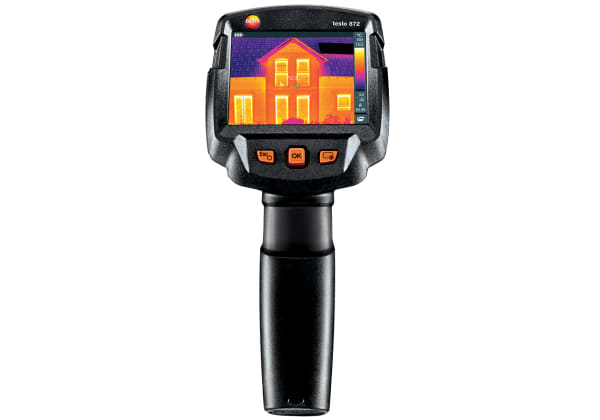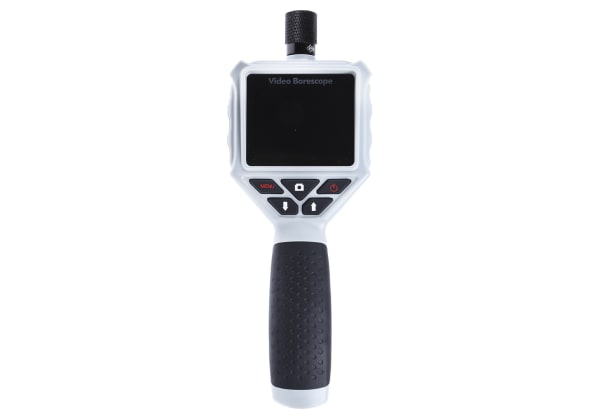- Published 17 Jan 2023
- Last Modified 29 Aug 2023
- 11 min
A Comprehensive Guide to Infrared Thermometers
How does an infrared thermometer work and how should you use it? Learn more in our IR thermometers guide.

Reviewed by Jay Proctor, Technical Support Team Leader (August 2021)
What are Infrared Thermometers?
An infrared thermometer is a non-contact means of measuring the temperature of an object. They are sometimes also referred to as IR thermometers.
Although their functionality is similar to standard contact thermometers, the key difference is that they work by inferring temperature from the infrared radiation that is emitted from the object or surface.
Infrared thermometers can be used in a wide variety of applications and industries for temperature measurement applications. They are versatile and can be highly useful, helping to screen objects, identify potential issues, and provide accurate temperature readings.
The History of the Infrared Thermometer
Radiation was first discovered at the start of the 19th Century, but it wasn’t until the late 1800s that it would be called infrared. The original iteration of the modern infrared thermometer was patented in 1901, yet commercial models were not available until the early 1930s.
Modern infrared thermometers became much more widely available around the millennium, and since then, they have become commonplace for a variety of applications and industries.

Who Invented the Infrared Thermometer?
The infrared thermometer was not invented by a single person. Instead, the technology and device we see today underwent a steady stream of development over the years. Notable names involved with its development include Johann Seebeck, Macedoni Melloni, and Theodore Case. There was also some military involvement and contribution from organisations like NASA.

When was the Infrared Thermometer Invented?
Several countries invested in infrared technology and the potential its use granted throughout the 1900s. Early commercial versions of the IR thermometer were available from the 1930s, but in its present form, the infrared thermometer was ultimately developed from the mid-20th Century onwards. Further refinements were continually made over time, as understanding progressed and infrared technology advanced.
What Does an Infrared Thermometer Measure?
Infrared thermometers are designed as a contactless way to measure the infrared energy being transmitted from the surface of an object. Ultimately, after a period of processing, the device will display the surface temperature of the object on its screen for the user to see.
IR thermometers can detect temperature from a distance, without the need for direct contact with the object. As a result, it should be noted that they can only measure the object’s surface temperature as opposed to its internal temperature. Some types of infrared temperature guns promise even more accurate readings by compensating for external environmental factors that could falsify the result, such as the ambient air temperature.
Most IR thermometers will show a single temperature on the display, either in °C or °F. There are, however, some high-end IR thermometers that show a thermal map of the whole view, while measuring the temperature of just one central point. This has the great benefit of being able to more easily see the hottest or coolest spot in view and helps guide you to measure that point if required. This is one step below a full thermal imaging camera, which allows you to capture and save the temperature of all points in the image at the same time.
What are Infrared Thermometers Used for?
A contact thermometer is an alternative temperature measurement device, the key difference being that it works by establishing direct contact between the probe and the surface. IR guns are typically used with objects that would be tricky to use a contact probe on. For instance, this could include objects that are moving, dangerous, or located in areas that are difficult to access.
These thermometers have numerous uses across a wide range of applications, industries, and environments. Just a few examples of possible uses include:
- Fast rotating machinery
- Air conditioning outlets in hard-to-reach locations
- Catalytic converters and automotive maintenance
They can also be used to measure the temperature of low-mass objects, where the use of a contact thermometer can actually sink away heat from the object being measured which would result in an incorrect reading. Non-contact temperature measurement avoids this problem.
How Does an Infrared Thermometer Work?
Infrared thermometers are passive devices, meaning that they only work with incoming infrared signals. The lens of the thermometer focuses incoming infrared radiation into a special sensor called a thermopile. This sensor then converts the infrared radiation into an electrical signal, which is amplified and converted into voltage.
The device processes this output, applying a temperature equation based on Planck’s Radiation Law, and electronically processing this to output the temperature reading. Depending on the model, it may also compensate for external factors like emissivity and ambient temperature at this stage. The temperature reading is then displayed on the screen of the device and may be recorded, if the model supports data storage, for the user to access when required.

Planck’s Radiation Law
Max Planck was a German physicist who proposed a mathematical representation of electromagnetic radiation, based on quantum theory. Planck’s law, shared in 1900, describes spectral radiance as part of a blackbody in thermal equilibrium, defining the quantity of energy produced using distinct frequencies.
How to Use an Infrared Thermometer
When using an infrared thermometer, the emissivity of the object being observed must be taken into consideration. Emissivity is the measurement of an object’s ability to emit infrared energy. This is important because the emissivity indicates the object’s temperature.
Emissivity is measured on a scale between 0 and 1.0, where 0 represents a highly reflective object like a mirror and 1.0 represents a blackbody (an idealised perfect radiator and absorber of electromagnetic radiation, with no reflecting power). For context, the majority of organic, oxidised, and painted surfaces will have an emissivity value around 0.95.
For this reason, if you are working with reflective metals, it is advisable to choose an infrared thermometer with an adjustable emissivity feature. This will allow the device to accommodate the emissivity of the target material and ensure the IR thermometer can perform efficiently and accurately. Most modern IR thermometers allow the user to manually adjust the emissivity value, but it is still worth double-checking to be sure your particular device supports this functionality.
Aside from the emissivity, another key point to consider when using an infrared thermometer is the field of view. This may also be referred to as the distance to spot ratio. For example, for a 12:1 distance to spot, at 12ft from the object, the detector will be looking at a spot on the object that will be 1ft in diameter. Sometimes, IR thermometers include a small laser to enable the user to see the centre of the focus spot. Alternative models feature multiple lasers which show the full spot of focus.
How Do You Calibrate an Infrared Thermometer?
A blackbody calibrator is a device designed to calibrate infrared thermometers. These are typically used by experts under controlled conditions to calibrate IR thermometers and certify the calibration standards.
If an infrared thermometer is found to be providing inaccurate readings, especially if compared to a calibrated thermometer taking readings of the same object under the same circumstances, the inaccurate device will need recalibration. However, you should bear in mind that external factors such as emissivity can play a role in the accuracy of an IR reading.
When calibrating an infrared thermometer, you need to:
- Be aware of external factors influencing measurement accuracy
- Perform calibration at ambient room temperature (ideally around 22° Celsius)
- Give the device time to acclimatise to the environment before calibrating it
- Take multiple measurements quickly to avoid giving the object’s temperature time to fluctuate between readings
Popular Brands
Testo
Browse our extensive range of infrared thermometers available from leading brand Testo and shop now with RS.
Fluke
Highly efficient and ergonomically designed, shop the full range of high-quality infrared thermometers from Fluke today.
RS Pro
See the full range of infrared thermometers available from RS Pro, our own in-house range, and shop online today.
FLIR
With a wide range of different models and features available, shop our full selection of FLIR infrared thermometers.
How Accurate are Infrared Thermometers?
The accuracy of IR thermometers varies between different models and manufacturers. For this reason, it is advisable to check the specifications to understand the accuracy of a particular device.
However, many modern infrared thermometers include a measurement error specification. This shows their best accuracy and allows the device to compensate for any errors received where possible. Other factors which may influence the accuracy of the reading include the material of the object being measured and its location as compared to the thermometer. The key aspects to take into consideration here are the emissivity of the object and the distance to spot ratio, as explained in the sections above.
An infrared thermometer's accuracy can also be affected by the presence of steam or dust in the atmosphere. As mentioned before, the IR thermometer reads surface temperature. If the first 'surface' it sees is steam or airborne dust, that is what it will measure, at least in part.
FAQs
How to Test a Catalytic Converter with an Infrared Thermometer?
Catalytic converters are devices used in vehicles to control exhaust emissions. They work to reduce pollutants and toxic gases generated from internal combustion engines, catalysing a redox reaction to minimise the toxicity of the pollutants.
Measuring the temperature of a catalytic converter can help to test and assess the efficiency of the device, and IR thermometers are the ideal tools for the job. The following steps explain how to test a catalytic converter with an infrared thermometer:
- The engine should be at operating temperature to enable an accurate reading to be taken
- Safely position the vehicle on a flat surface, where you can access the catalytic converter. Depending on the vehicle, a floor jack and support stands may be required
- Set the emissivity value on the IR thermometer if this is possible
- Position the thermometer close enough that the spot of focus includes only the part of the catalytic converter that needs measuring (as below) and not any surrounding parts which may influence the reading
- Take a reading of the inlet pipe (the pipe which connects to the front of the converter) with the infrared thermometer
- Take a reading of the outlet pipe (the pipe which connects to the rear of the converter) with the infrared thermometer
Once you have recorded the two readings, you can then analyse the results. A catalytic converter working optimally should be hotter at the rear than the front. If the two readings are similar or the reading from the front provides a higher temperature, this indicates that there may be an issue with the catalytic converter.
Can Infrared Thermometers Measure Water?
Infrared thermometers can measure water, but it is worth noting that they are only able to measure the surface temperature rather than the temperature of the liquid itself. This is because they are non-contact devices, so they are unable to detect the internal temperature due to the nature of the reading.
As a result, IR thermometers are unable to measure temperature through water or other liquids. It is also important to note that they will not accurately measure the temperature of water through tanks or containers such as glass beakers, even if the container material is transparent and visible light can pass through it. In this scenario, the device would simply take a reading of the container’s surface area rather than the liquid within it.
How Can I Measure the Temperature of Parts Inside a Cabinet?
As IR thermometers only measure the surface temperature of an object, as already mentioned, they cannot measure the temperature of parts inside. This is also applicable to clear Perspex panels, for example. To get an accurate measurement, it would be necessary to open the enclosure and point at the specific part that needs measuring. This does involve inconvenience at best, and at worst, considerable danger if high voltages are present.
Fortunately, there is a way around this. Special IR windows are available that allow you to measure the inside of a cabinet from the outside, without the need to open the enclosure.







